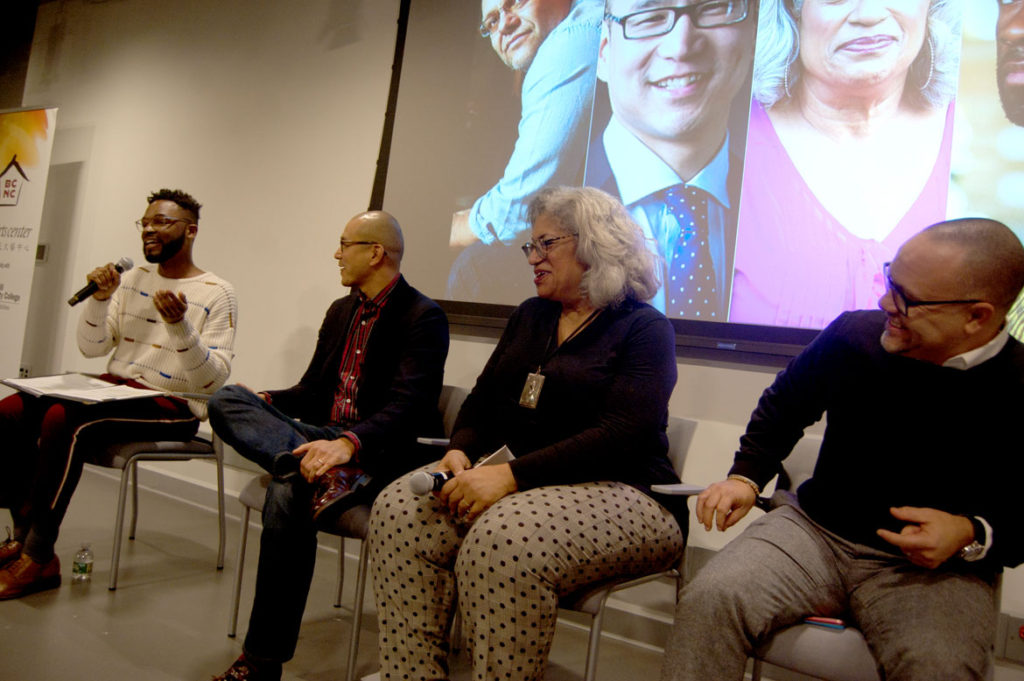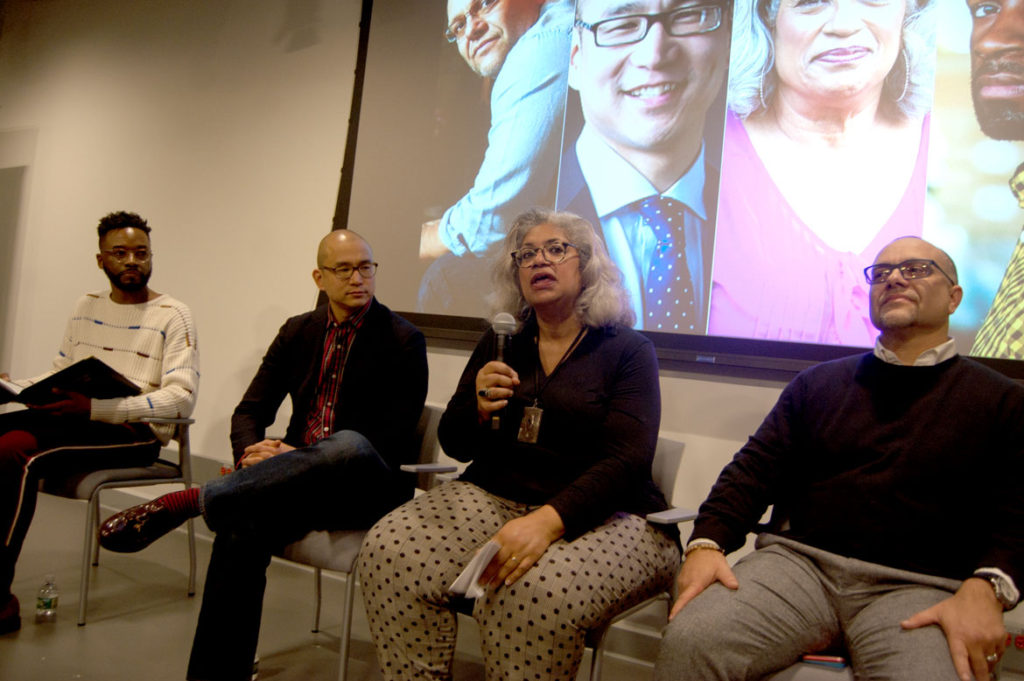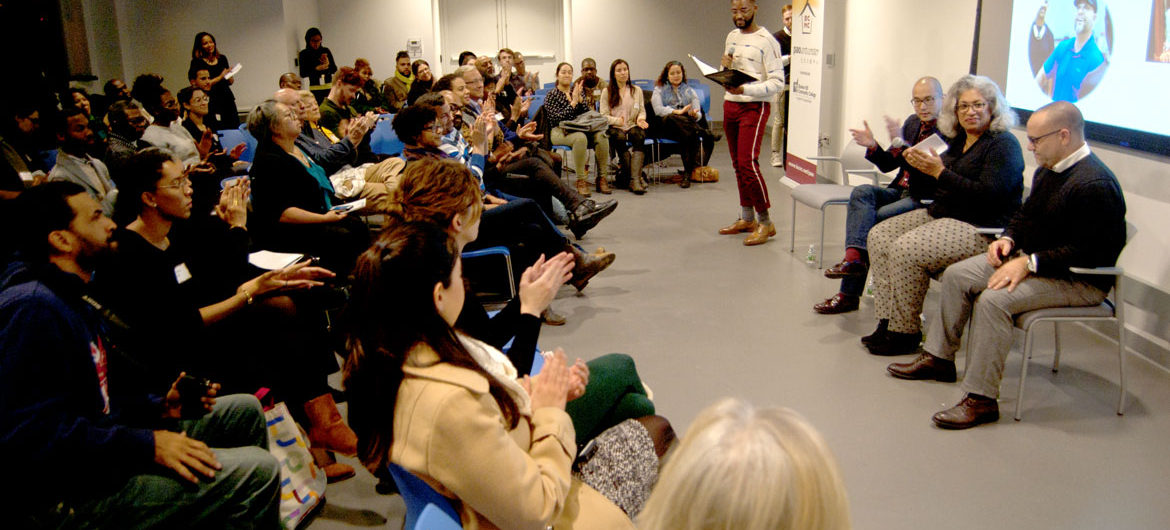“If this sector can’t be diverse and inclusive, who else can be?” Candelaria Silva-Collins asked at last night’s “Paving the Way: A Conversation with Leaders of Color in the Arts” at the Pao Arts Center in Boston. “Artists figure things out. Artists make a way where there’s no way. … If we can’t do this, and reflect our country and the whole world, who else can do this?”
The talk was presented by Boston’s Network for Arts Administrators of Color, which was launched last year by ArtsBoston, a consortium of local arts organizations, “to enhance the visibility of professionals of color in Greater Boston’s arts and culture sector, as well as widen the leadership pipeline and highlight opportunities for professional and personal growth in the field.”
Network founder Victoria George, also ArtsBoston’s Audience Lab director, said interest in the group—more than 200 people are now involved—challenges “assumptions that there aren’t enough qualified arts leaders of color in Boston.”

Moderator Todd McNeel, who is media coordinator for the Boston Lyric Opera, asked the speakers what progress they’d seen in diversity and inclusion in Boston.
Ben Hires, executive producer and chief strategy officer for the Boston Children’s Chorus, said that since he first came to Boston two decades ago, “The conversation around issues of diversity and inclusion has grown. … People are trying to understand what they can do to be more inclusive, to understand their blind spots, their privilege.”
“Just being in this room is incredible progress,” said Candelaria Silva-Collins, chair of Designators for the George B. Henderson Foundation and program manager for the Fellowes Athenaeum Trust Fund. “You have more diversity than ever. And yet you can still live a very black-only life here, a very white-only life here, a Chinese-only life, a Vietnamese-only.”
She worried about people of color being priced out of neighborhoods. She pushed for more real estate ownership. “If you own your space, you have so much more leverage than if you don’t.”
What organizations are doing good work to improve diversity and inclusion?
“ArtsBoston has taken a lead by doing whatever it took to attract Vicky George and to support her vision,” Silva-Collins said. “This can’t be a project, it has to be an organization.” So if George moves on, the work continues, she said.
“My frustration is seeing people doing things new that we did 30 years ago but for some reason it didn’t hold,” Silva-Collins said.
She called for racial parity in organizations. “A lot of organizations can be very white and still are very fragile in terms of the number of people of color. I can’t think of one organization that’s got it right, but there are a lot trying.”
“The infrastructure for arts organizations of color has been a little difficult to maintain in Boston,” Silva-Collins added.
Hires said, “ArtsEmerson has made great strides in programming to attract different audiences … to meet people where they’re at in their interests.” He then called for arts organizations to pursue more diverse audiences as well as leadership. “When you have that representation in cultural organizations or on your team, new and good things can happen that might not happen until you put the right people in place.”
“I think Boston seems to drive this conversation more [nationally] than I think you give yourselves credit for,” said Christopher Edwards, artistic director for the Actors’ Shakespeare Project, who moved to Boston from Las Vegas just a few months ago. “You’re probably on the forefront of this in the country as a group trying to make a difference. … I would give yourselves a little more credit.”
Hires said when the Boston Children’s Chorus was founded in 2003, “in the DNA of the organization was being diverse and welcoming all people and using the arts as a tool. … Very intentional, very top of mind.” But, he noted, “In many cases, arts organizations, they’re coming at it down the road in how to be diverse and how to be inclusive.” Particularly around Boston with anchor organizations that are more than a century old.
“The arts are incredibly healing,” Silva-Collins said. “I think we have to push beauty and the arts and culture in the same way people push drugs and racism and stupidity.”
“I think you have to be the only black person or Vietnamese person or Chinese person or Puerto Rican person in the room and be okay with that—if I’m invited into that room, I belong there—and not to be paralyzed by self-doubt,” Silva-Collins said. “But I don’t want to be alone, so I’m always trying to get other people invited as well.”

McNeel asked how can people of color climb the leadership ladder. Hires recommended joining the Network for Arts Administrators of Color and finding mentors.
“If you know about an opportunity, share it. If you’re going to apply for an opportunity, give yourself a day or two head start, then share it,” Silva-Collins said. Even if you don’t get the job, a friend you shared the opportunity with may get it, which could help you as well. She encouraged people to promote themselves. “If you don’t do ‘here I am, here I am’ sometimes people won’t notice you. You’ve got to be visible.”
“When I was growing up,” Edwards said, “my father said you have to work twice as hard. I took that into the world with me and that twice became three to four times. We have to give ourselves a break.”
Next steps for the city of Boston?
“Diversifying the board [of directors] is a big step,” Edwards said. “Because a lot of times the access is not afforded because the person coming in at an executive level is not able to connect with the folks who would be hiring them.”
“And support people of color,” Edwards said. “Because sometimes we get through the door and forget the door we came through. Support the people who are coming up.”
Hires called for more flexible hiring criteria. He recounted an anecdote about the Big Sister Association in Boston wanting to increase hiring of people of color but finding that their hiring criteria requiring candidates to have a master’s degree in social work excluded many talented candidates of color.
Silva-Collins recommended that employers commit to “we’re not going to fill the job until we’ve interviewed a diverse range of candidates.” She said many job-specific skills can be trained, but “You can’t train a personality. You can’t train eagerness.”
“People need to look at outreach not as a one-night stand, but a relationship,” Edwards said. “There’s a relationship leading up to the moment. And what happens when you leave? That’s the hard, hard time consuming work. And that has to be done.”
